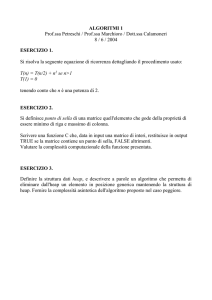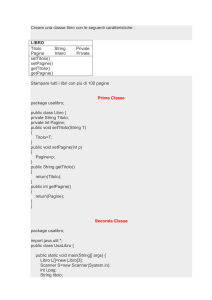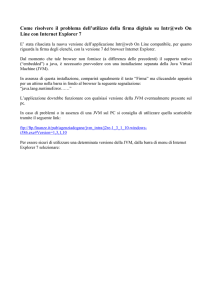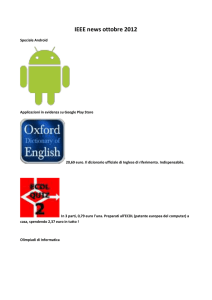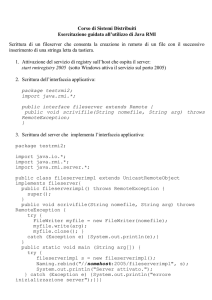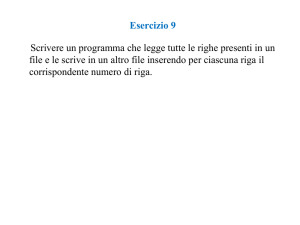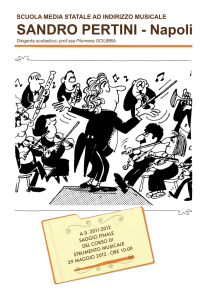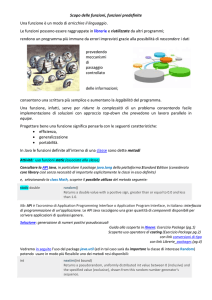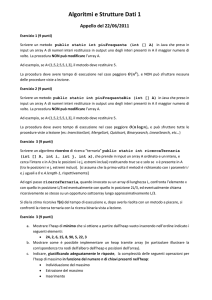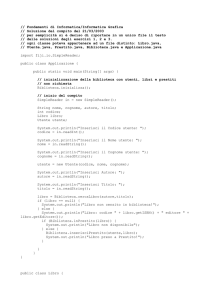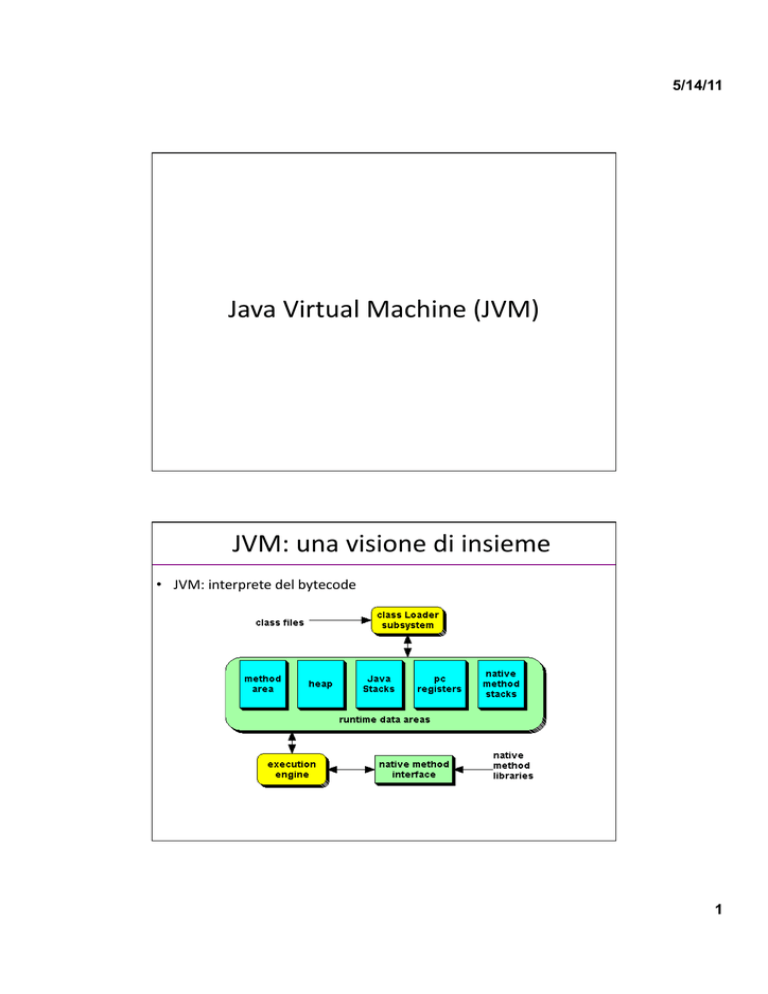
5/14/11
Java
Virtual
Machine
(JVM)
JVM:
una
visione
di
insieme
• JVM:
interprete
del
bytecode
1
5/14/11
Stru;ura
• Ogni
istanza
della
JVM
e’
cara;erizzata
– Area
per
memorizzare
le
tabelle
dei
metodi
– Heap
– Un
insieme
di
stack
(uno
stack
per
ogni
thread
in
esecuzione)
• Il
class
loading:
quando
l
JVM
carica
un
file
di
Gpo
class
inserisce
le
informazioni
nell’area
delle
tabelle.
• Gli
oggeK
sono
allocaG
sullo
heap
(dinamicamente)
• Stack
conGene
i
record
di
aKvazione
aKvi
Stru;ura
del
run
Gme
.
2
5/14/11
Il
Class
Loader
• Il
class
loader
ha
tre
funzionalita’
principale:
– Loading,
linking,
iniGalizaGon
• La
fase
di
linking
e’
stru;urata
in:
– verificaGon,
preparaGon,
resoluGon
Class
Loading
• Loading
=
– reading
the
class
file
for
a
type,
– parsing
it
to
get
its
informaGon,
– storing
the
informaGon
in
the
method
area.
• Quali
sono
le
informazioni
memorizzate
nella
method
area:
– The
fully
qualified
name
of
the
type
– The
fully
qualified
name
of
the
type's
direct
superclass
or
if
the
type
is
an
interface,
a
list
of
its
direct
super
interfaces
.
– Whether
the
type
is
a
class
or
an
interface
– The
type's
modifiers
(
public,
abstract,
final,
etc)
– Constant
pool
for
the
type:
constants
and
symbolic
references.
– Field
info
:
name,
type
and
modifiers
of
variables
(not
constants)
– Method
info:
name,
return
type,
number
&
types
of
parameters,
modifiers,
bytecodes,
size
of
stack
frame
and
excepFon
table.
3
5/14/11
Class
Loading
•
Alla
fine
del
processo
di
loading
vengono
create
tu;e
le
stru;ure
per
operare.
In
parGcolare
vengono
creaG
alcuni
metodi
della
classe
class
java.lang.Clas
che
perme;ono
la
instrospecGon
da
programma
public String getName()
public Class getSupClass()
public boolean isInterface()
public Class[] getInterfaces()
public Method[] getMethods()
public Fields[] getFields()
public Constructor[] getConstructors()
Si
deve
prima
invocare
il
metodo
getClass()
sull’istanza
T
per
o;enere
il
riferimento
all’istanzaT.
Class
loading
import java.lang.reflect.Method; // Required!
//you must import your Circle class
public class TestClassClass{
public static void main(String[] args) {
String name = new String(“Ahmed”);
Class nameClassInfo = name.getClass();
System.out.println("Class name is : “ + nameClassInfo.getName());
System.out.println("Parent is : “ + nameClassInfo.getSuperclass());
Method[] methods = nameClassInfo.getMethods();
System.out.println("\nMethods are: ");
for(int i = 0; i < methods.length; i++)
System.out.println(methods[i]);
}
}
4
5/14/11
Cosa
si
vede
public methods are displayed ONLY!
Linking
• Linking:
VerificaGon,
PreparaGon
e
ResoluGon
• VerificaGon:
Verifica
se
I
binari
hanno
la
stru;ura
corre;a
– Manuali
SUN:
“The
JVM
has
to
make
sure
that
a
file
it
is
asked
to
load
was
generated
by
a
valid
compiler
and
it
is
well
formed”
– Examples:
– Every
method
is
provided
with
a
structurally
correct
signature
– Every
instrucGon
obeys
the
type
discipline
of
the
Java
language
5
5/14/11
PreparaGon
• Viene
allocata
la
memoria
per
la
classe
(variabili
staGc)
e
vengono
definiG
I
valori
iniziali.
• Sempre
dai
manuali
“no
java
code
is
executed
unGl
iniGalizaGon”.
• Valori
di
defauly:
ResoluGon
•
•
ResoluGon:
in
questa
fase
vengono
sosGtuiG
I
valori
simbolici
con
I
riferimenG
a;uali
in
memoria
Esempio
la
classe
seguente
richiede:
TestClassClass,
String,
System
and
Object.
public class TestClassClass{
public static void main(String[] args){
String name = new String(“Ahmed”);
Class nameClassInfo = name.getClass();
System.out.println("Parent is: “ + nameClassInfo.getSuperclass());
}
}
•
•
I
nomi
erano
memorizzaG
nel
constant
pool
di
TestClassClass.
La
risoluzione
rimpiazza
I
nomi
con
I
riferimenG
effeKvi
a
run‐Gme.
6
5/14/11
Class
IniGalizaGon
•
Inizializzare
la
classe
come
ha
voluto
il
programmatore.
class Example1 {
static double rate = 3.5;
static int size = 3*(int)(Math.random()*5);
...
}
•
•
•
Due
fasi:
– Inizializzazione
delle
superclassi
(se
esisono)
– Eseguire
l’inizializzazione
Quale
e’
la
prima
classe
inizializzata?
staGc
final
variables
(ostanG)
sono
compilate
dire;amente
class Example2 {
static final int angle = 35;
static final int length = angle * 2;
...
}
IniGalizaGon
• A
questo
punto
una
classe
e
pronta
per
l’uso.
• Quando
una
classe
viene
creata
una
sua
istanza
e’
allocata
sullo
heap
• L’operazione
viene
fa;a
per
le
super
class
e
tu;e
le
classes
della
gerarchia.
• Le
variabili
di
istanza
vengono
inizializzate
ai
valori
di
default.
• Viene
invocato
il
metodo
costru;ore.
• Viene
resGtuito
il
cammino
di
accesso
all’ogge;oi
creato
sullo
heap.
7
5/14/11
ESEMPI
8
5/14/11
9
5/14/11
10
5/14/11
11
5/14/11
12
5/14/11
OggeK
e
Heap
• Ogni
ogge;o
allocato
sullo
heap
conGene
un
puntatore
alla
tabella
dei
metodi
della
classe
• L’invocazione
del
metodo
o.m()
uGlizza
il
puntatore
alla
tabella
dei
metodi
per
effe;uare
il
“dispatch”.
Questo
potrebbe
comportare
una
operazione
di
ricerca
nella
gerarchia
• Metodi
hanno
un
campo
this
che
punta
all’ogge;o
che
ha
operato
la
chiamata
del
metodo.
13
5/14/11
INIT
INIT
14
5/14/11
INIT
15
5/14/11
FIELD
ASGN
16
5/14/11
DONE!!
GO
AHEAD!!
17
5/14/11
18
5/14/11
19
5/14/11
C++
Virtual
Met
20
5/14/11
21
5/14/11
STATIC
TYPES
GARANTISCONO
LA
CORRETTEZZA
22
5/14/11
FINALMENTE
…
SIAMO
ARRIVATI
IN
FONDO
:
CHE
FATICA
23
5/14/11
STATIC
24
5/14/11
OVERRIDING
25

